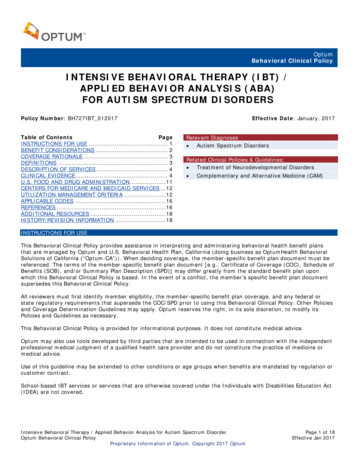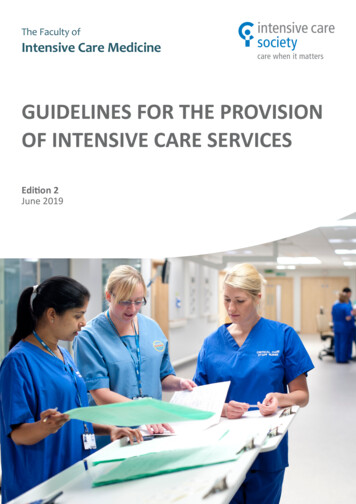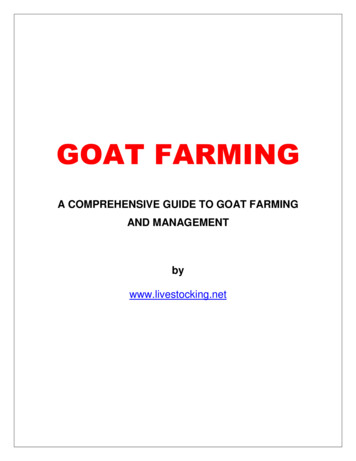
Transcription
JEIBIVOLUME 5 – NUMBER 1Three Years of Intensive Applied Behavior Analysis:A Case StudyOlive Healy, Jennifer O’ Connor, Geraldine Leader and Neil KennyAbstractA 2 years and 10 months old child receiving an early intensive teaching program using theComprehensive Application of Behavior Analysis to Schooling (CABAS ) was taught usingevidence-based teaching strategies and curricula based on existing research in both the applied andbasic sciences. Progress was measured using behavioral assessment tools and mastery of pre-setlearning criteria . Independent measures in the form of psychological assessments were alsoadministered annually over a three year period. This paper will provide an overview of the learningprofile provided and the results achieved.Keywords: Autism; Early intervention; Evidence-based teaching, CABAS , OutcomesFor more than thirty years empirical studies have been conducted and published in numerouspeer-reviewed journals showing the efficacy of applied behaviour analysis (ABA) in the treatment ofautism spectrum disorders. It is not surprising given the years of dedication by many well respectedresearchers that ABA has more empirical support than any other treatment or therapy for childrendiagnosed with autism. It incorporates numerous teaching strategies, each of which have an empiricalbasis demonstrating their effectiveness. (Matson, Benavidez, Compton, Paclawskyj, & Baglio , 1996).Applied Behaviour Analysis is a science-based approach to education. Numerous governmental andprivate agencies in the U.S.A. have endorsed it as the preferred therapy for children with autism (e.g.,Surgeon-General, 1999; Maine Administrators of Service for Children With Disabilities, 2000; NewYork State Department of Health, 1999). There are hundreds of objective research studies that haveshown applied behavior analysis to be an effective method for teaching language and communication,social and leisure skills,and independent functioning, as well as reducing, replacing and eliminatingchallenging behaviours (Matson et al., 1996.)There are a number of comparison studies that have ‘tested’ the outcomes of treatmentmodels for children with autism. The first large-scale and most well documented outcome study ofABA as a treatment for autism was published by Lovaas (1987). Out of 19 children given 40 hours ofone-on-one treatment for two years, almost half were able to complete a typical first grade classwithout special supports or accommodations. These nine children achieved IQ scores in the normalrange (94-120). They had achieved typical or average functioning both developmentally andeducationally. In a follow-up study aimed at investigating the long-term outcomes of these samechildren, McEachin, Smith, and Lovaas (1993) found that IQ and behavioral gains were maintainedover about a ten-year period. Using double blind clinical assessments, eight of the nine children withthe best outcomes were indistinguishable from normal controls based both on clinical evaluation aswell as standard clinical assessment measures. Results indicated that these children continued tofunction normally into adolescence (McEachin et. al., 1993).A study conducted by Anderson, Avery, DiPietro, Edwards, and Christian (1987) producedresults similar to Lovaas’, but did not include a control group. Three additional studies have in partreplicated Lovaas’ original findings and demonstrated results in significant gains intellectually or inprecise skills for participants (Birnbrauer & Leach, 1993; Sheinkopf & Siegel, 1998; Smith, Eikseth,Klevstrand, and Lovaas, 1997). All three of these studies demonstrated IQ improvements and othergains in children receiving ABA, although not to the same degree demonstrated by Lovaas (1987).However, the intensity of treatment differed somewhat from that in the Lovaas study with fewer hoursof ABA intervention per week, so it is difficult to draw comparisons. Like Lovaas (1987), Sallows &Graupner (2001) demonstrated that 45% of those receiving ABA treatment in their study (these4
JEIBIVOLUME 5 – NUMBER 1children were considered to show the best outcomes) achieved average levels of intellectualfunctioning. While earlier research investigated the different effects of varying the intensity oftreatment, more recently, research has focused on comparison of treatment types.For example, recent studies have indicated important outcomes by providing a comparisonbetween the use of an applied behavior analysis approach and ‘eclectic’ mixtures of procedures. Suchstudies presented one group of children with an applied behavior analysis program that emphasizedthe use of empirically supported techniques, such as reinforcement strategies, shaping, prompting,functional communication training etc. in structured, informal one-on-one and group settings. Asecond group of children received a variety of teaching procedures, including a component of appliedbehavior analysis, Treatment and Education of Autistic and Related Communication HandicappedChildren (TEACCH; e.g., Schopler, 1997) sensory integration, music sessions, and circle time.Children in the ABA group received treatment for 28 hours per week in the first study (Eikeseth,Smith, Jahr, & Eldevik, 2002) and for 40 hours per week in the second study (Howard, Sparkman,Cohen, Green, & Stanislaw, 2005). Results of both of these studies at follow-up indicated that thechildren receiving the applied behavior analysis program scored higher on standardised test, and hadmade more progress in a number of domains than the children in the other groups. Findings werereported in areas of language, communication, social skills, independence, and problem behaviors.Most recently, Remington et al., (2007) compared the effectiveness of early intensivebehavioral intervention (EIBI) with a standard ‘eclectic’ preschool provision. Results showed thatEIBI led to significant, positive changes amongst the children with autism, including gains inintelligence, language and daily living skills, as well as in motor and social skills. In addition, thesepositive changes in children were achieved without negative impact on the psychological wellbeing ofparents. Remington et al. argue that further research is required to identify factors that best predict theeffectiveness of the intervention, factors that increase its impact, and factors that ensure its benefitsare maintained in the longer term.Reed, Osborne & Corness (2006) compared home-based interventions for young childrenusing applied behavior analysis models. Hi- intensity (mean of 30 hours per week) and low-intensity(mean of 12 hours per week) applications were compared. Children in the high-intensity group mademore gains in educational progress and cognitive functioning that the children in the low-intensitygroup. Additionally, when the three types of hi-intensity applications were compared, the CABAS approach was found to produce superior gains “.in terms of statistical significance and effect sizes.”(p. 10).Case studies have been documented in which independent evaluators used objectivemeasurement instruments to track children's progress (Green, Brennan, & Fein, 2002; Perry, Cohen,& De Carlo, 1995). For example, Perry et al. report the effectiveness of early intensive behavioralintervention with two siblings with autism diagnoses. The intervention involved up to 35 hours ofintensive 1:1 teaching sessions. Professionals who diagnosed the children evaluated their progresssystematically and reported that both no longer met the criteria for diagnosis of autism.Since the publication of the Lovass study in 1987 there has grown a number of prominentbehavioral approaches to treating autism. One such approach is a school-based intervention based onover 26 years of research by Professor R. D. Greer and his colleagues. The approach is a called TheComprehensive Application of Behavior Analysis to Schooling (CABAS ) (Greer, 1994a, Greer,Keohane & Healy, 2002; Lamm & Greer, 1991). It is a research-based, systems-based approach,school-wide application to education. The system has accrued an extensive database for developingand maintaining quality applications. CABAS professionals draw on the existing 65 years of basicand applied research in behavior analysis and 22 years of research in verbal behavior based onSkinner’s theoretical model (1957) to design curriculum for students, teachers, and teacher mentors,measure results, and inform new research.5
JEIBIVOLUME 5 – NUMBER 1Research drives, instruction for acquisition as well as performance tasks, and supportscurricula for students, and the training and monitoring of teachers, parents, supervisors, and systemsperformance (Greer, 1987; 2002; Greer, Keohane & Healy, 2002). This systems science of schoolingcan produce from four to seven times more learning than the learning found in normative practice(Albers & Greer, 1991; Diamond, 1992; Ingham & Greer, 1992; Selinski, Greer, & Lodhi, 1991).The CABAS system not only adopts the entire behavioral research literature whereappropriate for analyzing the learner but it similarly adopts the relevant literature for monitoring theprogress and the skills of the teacher (Keohane & Greer, 2005). Intensive one-to-one interactionsinvolve two persons, both child and educator. Many behavioral approaches analyze and monitor thechild's progress, but omit an examination of the effectiveness of the educator in presenting theteaching material or in shaping the target response. In addition to a detailed analysis of the level ofeffective and appropriate teaching of educators, continuous assessment and monitoring of allinstructors at all levels is conducted. This emphasis on both sides of the learning equation and on allindividuals at all levels of participation produces a system of instruction that is constantly evolvingand perfecting itself. CABAS is the only such system which does this (Greer, Keohane, & Healy,2002).The current study provides a case study of an early intensive behavioral intervention based onthe CABAS system for a young child diagnosed with autism spectrum disorder and tracks theprogress made based on independent psychological assessments and behavioral assessment tools.MethodParticipantThe participant was born on March 11th 2000. She was full-term and there were nocomplications at birth. She had one brother aged 11 and lived at home with both parents. She wasdiagnosed with Autism Spectrum Disorder at age 2 years and 2 months. At the time of entry into theCABAS program, the participant was aged 2 years and 10 months.Assessment HistoryThe first assessment was conducted in April 2002 when the participant was 2 years and 1month of age. At this point there was a suggestion of a possible diagnosis of Autism SpectrumDisorder. A follow-up assessment was recommended following one month.The second assessment was conducted in May 2002, at 2 years and 2 months.It was concluded by the psychologist that ‘present assessment and the developmental profile obtainedfrom parents confirm that the child has the impairments of social interaction, social communication,social imagination, and tendency towards repetitive behaviour patterns which are diagnostic of anautistic spectrum disorder’The third assessment in July 2002, at 2 years and 4 months, was conducted to determine anappropriate educational provision. It was concluded that the participant displayed poor compliance toadult directions, poor attention to tasks and difficulties with compliance, stereotypical patterns andself-stimulatory behaviors, language and social communication difficulties that impacted primarily onher ability to learn. The following is a summary of the deficits highlighted in the third assessment:§§§§§§§not toilet trainedfed with a spoon and drinks from a bottlereceptive and expressive language skills are delayedhas 3 words (sorry, no and now)communicates by leading people by the hand to what she wantsobject exchange e.g., brings bottle to ask for itemsvisitors to the house are ignored6
JEIBI§§§§§§§§§§VOLUME 5 – NUMBER 1just beginning to imitate actions of favorite characters on TVrepetitive hand movements - she clenches her hands and presses them tightly up against herfacewalks on tip-toesdislikes loud noises (e.g., runs from the garden when she hears the lawnmower)has a fascination with a toothbrush and likes to have one in her handwatches videos in a repetitive fashiondifficult to get her to do something she doesn’t want to doattention to adult-driven tasks is more limited than it is for self-chosen activitiesvery limited expressive language skillscore difficulties with comprehension affect her ability to perform in a range of activitiesIt was recommended, following this assessment that the participant should immediately access anautism-specific educational environment and a teaching approach based on applied behavior analysis.The CABAS SystemThe Comprehensive Application of Behaviour Analysis to Schooling (CABAS ) is a systemfor developing and maintaining quality in schools that provides a system-wide application of behavioranalysis to all of the components of education including curricula focused on the education of thewhole child (e.g., language acquisition, social skills, academic skills), and protocols to induce prerequisite verbal developmental cusps (Greer, 2002; Keohane & Greer 2005; Greer & Ross 2008) . Thesystem has been developed using an extensive database for ensuring and maintaining qualityapplications. Those components include: minimal standards of teaching as applied behavior analysis,curricula for teachers and other professionals, research-based tools to train and monitor professionalsand, curriculum revisions for students occasioned by research.In January 2003, an early intervention program based on the Comprehensive Application ofBehavior Analysis to Schooling (CABAS ) was established at the opening of the Dublin CABAS School, based on parent initiative. The participant was enrolled in the program which applied thefollowing teaching practices:§§§§§§§Logical and empiraclly based curricular sequencesFunctional curriculum based on an analysis of verbal behavior across domains1:1 teacher/student ratio of instructionLogical curricular sequences based on research and eduactional standardsPersonalised System of Instruction (PSI) (Keller, 1968)Peer tutoringGroup Instruction (e.g. use of direct instruction curricula and observational learning)The intervention program was characterised by several key tools that are used to teachdifferent repertoires and maintain and motivate performance. These tools are derived from ongoingresearch. Some of these tools include: use of learn unit instruction (Bahadorian, 2000, Greer &McDonough, 1999), the Teacher Performance/Rate Accuracy Observation Protocol (Ingham & Greer,1992), the CABAS Decision Protocol (Keohane, 1997; Greer (revised August 2001); Keohane &Greer, 2005), implementation of a parent education program; and system monitoring and staff training(Greer, 1997).Learn Unit Instruction: The learn unit is a measure of both the accuracy of teacherpresentations and the productivity of instructors (Greer & McDonough, 1999). The learn unit is acomplex but robust predictor of student or client outcomes. In CABAS schools, learn units aregraphed by curricular areas and individual programs. The learn units taught to students by curriculararea are critical in assessing whether the student is receiving necessary and sufficient instruction. Inaddition, learn units are graphed to criterion at the levels of individual students, instructors,classrooms, and school-wide.7
JEIBIVOLUME 5 – NUMBER 1Teacher Performance Rate/Accuracy Performance Protocol (TPRA): This observationprotocol measures the instructor’s accuracy and rate at presenting learn units to students.Presentations of instructional units that are learn units predict student outcome and can increase fromfour to seven times (Ingham & Greer, 1992). In CABAS schools, supervisors use the TPRAprocedure on a regular basis to dramatically improve the prognosis of the student, whether the studentis receiving massed or captured learn units (e.g., incidental learn units). The procedure affects teacherperformance almost immediately and its continued use insures consistent quality. The TPRA is ameasure also of the accuracy of teachers’ data as well as their instructional accuracy.CABAS Decision Protocol: This protocol involves continual review and scripting of longterm objectives that were broken down into short-term objectives. One of the key aspects of qualityinstruction is the accuracy of the practitioner’s use of visual displays of data to insure that thestudent/client is making progress towards long and short-term objectives. Decisions to alter short-termobjectives were based on visual displays of data and the use of ‘The decision tree protocol’ (Keohane,1997; Greer (revised August 2001); Keohane & Greer, 2005). The practitioner’s use of visual displaysof data to insure that the student is making progress towards long and short-term objectives is a keymeans of monitoring the degree to which the practitioner is acting as a strategic scientist. Researchdemonstrates that when the decision tree protocol is used by instructors, students learn significantlymore than when it is not used (Keohane, 1997; Keohane & Greer, 2005; Nuzzolo-Gomez, 2002).Parent Education Program: As part of the initiative, parent education was provided withinthe school once per month. This allowed the participant’s parents to attend the school to learnbehavior change procedures that would be effective within the home setting. Training was given bythe school director and involved a generalization plan for mastered skills. Procedures were modelledby the school instructors and parents were taught how to deliver learn unit instruction. Theparticipant’s parents were required to participate in the initial assessment of skills, assist inestablishing specific objectives as targets within the home setting and demonstrate direct instructionfollowed by feedback from the school director.System Monitoring and Staff Training: In addition, the quality of the training programdelivered to staff ensured that certain expected standards were met resulting in continuedimprovement in the quality of the professional service delivered. In this particular case, the CABAS system for ongoing staff training builds on Keller’s Personalised System of Instruction (PSI) approach(Keller, 1968) within a ‘rank’ training protocol. That is, the components of behavior analytic teachingand supervision are divided into three categories for each rank, and arranged from less difficult tocomplex. Professionals move through the levels of expertise in an individual fashion.The three broad repertoires of teachers as scientist-practitioner are: (a) the vocabulary of thescience of applied behaviour analysis or verbal behavior about the science, (b) classroom andsupervisory practice in situ or contingency-shaped repertoires of in class practice, and (c) verballymediated repertoires making decisions about applications of behavioral strategies. Instruction in thesethree repertoires is arranged in levels of difficulty or modules that are tied to three teacher ranks(Teacher I, II, and Master Teacher), followed by three behavior analyst ranks, and three researchscientist ranks. There are 10 modules for each of the three repertoires and several components withineach module . A component in a module is an instructional objective for the professional. Forexample, in the first teacher rank there are 87 individual criterion referenced-objectives orcomponents in the 30 modules. The ranks, and the modules in each rank, are used as a way toorganize professional instruction by levels of difficulty, motivate staff, recognize achievement, andacknowledge expertise. When individuals in CABAS schools complete the requirements for eachrank under the supervision of a senior behavior analyst, those individuals may submit theirachievements to the CABAS Professional Advisory Board for board certification. The CABAS model of behavioral instruction is one of the very few models which have produced valuable researchinto the role of teaching in relation to student progress (Greer, 1994b; 1996a; 1996b, Greer, 2002).8
JEIBIVOLUME 5 – NUMBER 1The quality of program delivery in the participant’s school was set up by the Senior CABAS Consultant and the Associate CABAS Consultant for the CABAS model and maintained throughthe use of a hierarchy of supervision with close monitoring by two doctoral level consultants. Theconsultants were both certified by the CABAS Board of Directors as Senior Research Scientist, andAssistant Research Scientist, and provided consultancy to the school four times annually. In addition,a further professional provided inservice training in Applied Behavior Analysis to the school six timesannually. This consultant was certified within the CABAS system as an Assistant Behaviour Analystand was also certified as a Board Certified Behavior Analyst from the Behavior Analyst CertificationBoard (BACB ). The school was directed by a doctoral level behaviour analyst who was certified as aCABAS Master Teacher and received ongoing training in the CABAS system from bothconsultants. The system provided ongoing instruction and monitoring of all instructors within acurriculum for the education of professionals, a continuous monitoring of system for maintainingquality applications by professionals, and a motivational system (Greer, Keohane, & Healy, 2002).Twelve of the instructors at the school were certified as Teacher I ranks and four were certified asTeacher II ranks.CurriculaCurricula r goals were derived from The Preschool Inventory of Repertoires for Kindergarten(PIRK ), (Greer & McCorkle , 2003) which is a curriculum for use within CABAS accreditedschools only, and The Assessment of Basic Language and Learning Skills (ABLLS) (Partington &Sundberg, 1998). The PIRK constitutes the curricular objectives for teaching the repertoiresnecessary for a child to excel in Kindergarten including the repertoires associated with academicliteracy, communication, self-management for school self sufficiency, social self management,community of reinforcers (inventory of the child’s interests and preferences), and physicaldevelopment. That is, the assessment covers what a child needs to be very successful in the school,the home, and the community. This assessment is based on behavior analysis and pedagogicalresearch. It includes 242 objectives across 14 different curricular areas. Curricular goals are thenselected based on deficits identified in the PIRK.The ABLLS protocol is an assessment, curriculum guide, and skills tracking system forchildren with language delays. It contains a task analysis of 455 skills divided into four broadcategories (basic learner skills assessment, academic skills assessment, self-help skills, and motorskills assessment). In total, there are 24 different areas of ability across each of the broader categories.InterventionDuring the early phases of instruction, the participant would not sit down in a chair, displayedno appropriate forms of communication, displayed tantrum behaviours and cried for most of theschool day, gathered items, displayed no eye contact, had little or no appropriate play skills, anddisplayed high rates of self-stimulatory behaviour by tensing her arms and contorting her upper body.An intensive school-based intervention was delivered that involved 32.5 hours per week using TheCABAS System outlined above.Socially significant objectives were selected and prioritized during the early stages ofintervention. Goals were operationalized and criterion referenced. Instruction for each long term goalwas provided using scientifically derived tactics and interventions from the research literature inapplied behavior analysis. Teaching was provided using learn unit presentations. During dailyintervention for the participant, instructors graphed all correct responses to learn units according tocurricular areas and individual programs. Instruction was provided in the following curricular areas inaccordance with the CABAS educational system:§§Communication (speaker and listener objectives)Academic literacy9
JEIBI§§§§VOLUME 5 – NUMBER 1Problem-solvingSelf-management and social self-management (behaviour management, social skills, self-helpand school routines)Physical repertoirePlay and leisure skills (enlarging community of reinforcers)Performance was measured throughout instruction and included total learn units and correct responsespresented daily (broken into curricular area and individual programs), cumulative criteria and learnunits to criterion.MeasuresThe participant was evaluated by the same independent, self-employed educationalpsychologist three times across a three year period (2004-2006). This psychologist was a registeredmember of the British Psychological Society and was qualified in the administration of diagnostic andassessment tools. The measures employed covered three broad areas: autistic severity (Gilliam AutismRating Scale), educational functioning (British Abilities Scales II), and adaptive behavioralfunctioning (Vineland Adaptive Behavior Scale).Gilliam Autism Rating Scale: The Gilliam Autism Rating Scale (GARS; Gilliam, 1995)comprises four subtests, each describing behaviors symptomatic of autism. These subtests are:Stereotyped Behaviors – describing stereotyped behaviors, motility disorders and other unique andstrange behaviors. Communication – describes verbal and nonverbal behaviors that are symptomaticof autism. Social Interaction – evaluates the child’s ability to relate appropriately to people, events,and objects. Developmental Disturbances – asks questions about the child’s development during earlychildhood. The raw scores from these subscales can be converted into standard scores (mean 100,standard deviation 15). These subscales combine to give an Autism Quotient, high scores meaninggreater autistic severity (mean 100 [average autistic severity], standard deviation 15).According to Gilliam (1995) the scale is appropriate for persons aged 3 to 22 years, and iscompleted by parents or professionals in about 10 minutes. Its internal reliability ranges from 0.88(Developmental Disturbances) to 0.93 (Social Interaction), with the overall Autism Quotient havingan internal reliability of 0.96. The GARS has high criterion validity with other tools, for example, theAutism Behavior Checklist (0.94).British Abilities Scale: The British Abilities Scale (BAS II; Elliott, Smith, & McCulloch,1996) is a battery of tests of cognitive abilities, which index educational achievement. It is suitable foruse with children and adolescents from two years, six months old (2:6) to seventeen years, elevenmonths old (17:11). The present use of the test concerned educational achievement, and therefore theVerbal Cluster, Pictorial Reasoning Cluster, and Spatial Cluster subscales were used. These scalesallow the calculation of a General Cognitive Ability scale (mean 100, standard deviation 15),which represents early educational achievement.Vineland Adaptive Behavior Scale: The Vineland Adaptive Behavior Scales (VAB; Sparrow,Balla, & Cicchetti, 1998) is a semi-structured interview, administered to a parent or other caregiver ofthe child. It can be used from birth to 5:11 years, making it suitable for the present participant. TheVAB scale assesses children’s day-to-day adaptive functioning. Scores from four domains of adaptivebehavior were used in the present study: Communication – reflecting the child’s receptive, expressive,and written language skills; Daily Living Skills – reflecting the child’s personal self-care, domesticand community living skills; Socialization – reflecting the child’s interpersonal play or leisure skills,and coping skills; Motor Skills – reflecting the child’s ability to utilize implements. The raw scorescan be converted to standard scores, and a Composite Overall score can be derived based on sum ofscale standard scores (mean 100; standard deviation 15). Sparrow et al. (1999) have reported thatthe internal reliability of the subtests ranges from 0.80 (Daily Living Skills) to 0.87 (Socialization),with the Overall Composite score having an internal reliability of 0.93.10
JEIBIVOLUME 5 – NUMBER 1Systematic Integration into the Mainstream SettingDuring the period from October 2005 to November 2006, the participant began to attend amainstream primary school for integration purposes. She was accompanied by an ABA instructor whoprovided prompting when necessary to acquire learning targets. Such learning targets during the earlystages of integration included play and social skills, and were gradually increased to include academicgoals in a large group instructional situation. Behavioral tactics were employed within this setting,e.g. self-management for peer initiations and self-management of self-stimulatory behavior. Learningduring this period was also measured and decisions about increases in integration were data -based.The participant attended for Junior Infant classes up to June 2006 (The Irish Primary Schooldesignates the first year of school as junior infants, the second year as senior infants; all remainingschool years are labelled first to sixth classes). Peers in this class were on average one year older thanthe participant. In September 2006 the participant began attending first class which was the age appropriate grade level.ResultsAssessments were carried out over a three year period by an independent educationalpsychologist to review progress made. Table 1 summarizes the recommendations made by theindependent psychologist following each assessment. The psychologist outlined that during an earlyassessment, the participant displayed a ‘moderate-severe cognitive deficit at that time and indicated asignificant learning disability.’ H
The current study provides a case study of an early intensive behavioral intervention based on the CABAS system for a young child diagnosed with autism spectrum disorder and tracks the progress made based on independent psychological assessments and behavioral assessment tools. Method Participant The participant was born on March 11th 2000 .










